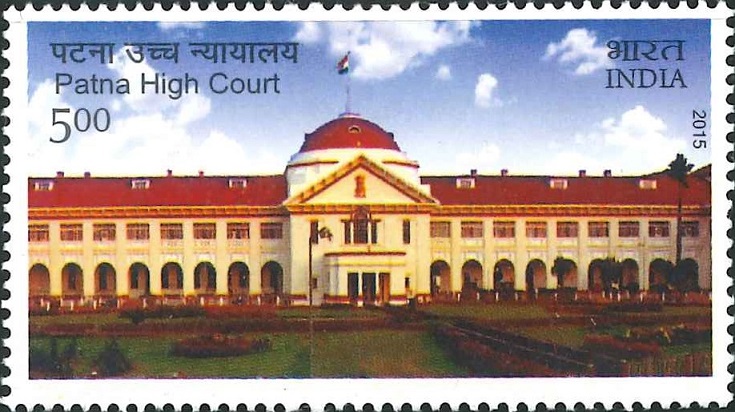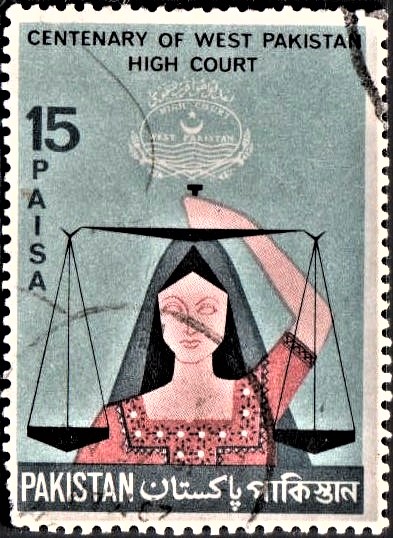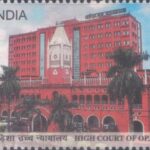
Patna High Court
A commemorative postage stamp on the Centenary of The High Court of Judicature at Patna, the High Court of Bihar :
 Issued by India
Issued by India
Issued on Apr 18, 2015
Issued for : Department of Posts is happy to celebrate 100 years of the High Court of Judicature, Patna by issuing a commemorative postage stamp on Patna High Court.
Credits :
Stamp/FDC : Brahm Prakash
Cancellation : Alka Sharma
Type : Stamp, Mint Condition
Colour : Multi colour
Denomination : 500 Paise
Stamps Printed : 0.6 Million (0.1 Million for the proponent)
Printing Process : Wet Offset
Printer : Security Printing Press, Hyderabad
About :
- The territories of Bihar and Orissa which were formerly subject to and included within the limits of the Presidency of Fort William in Bengal, were promoted to the status of a separate province, through the Proclamation made by the Governor-General of India on 22nd March, 1912. By Letters Patent, dated the 9th February, 1916 the Patna High Court was ushered into existence with Circuit sittings at Cuttack, and from the 26th February, 1916, the date on which the aforesaid Letters Patent was published in the Gazette of India, the High Court of Judicature at Fort William in Bengal ceased to exercise jurisdiction, Civil, Criminal, Admiralty, Matrimonial, Testamentary and Intestate, Enrolment, etc. in all matters in which jurisdiction was given to the High Court of Judicature at Patna. Thus, the ancient city of Pataliputra had a High Court of its own in 1916 with Sir Edward Maynard Des Champs Chamier, Kt. Barrister-at-Law as its first Chief Justice and Sarvashri Saiyid Sharfuddin, Barrister-at-Law, Edmund Pelly Chapman, I.C.S., Basant Kumar Mullick, I.C.S., Francis, Reginald Roe, I.C.S., Cecil Atkinson, barrister-at-Law and Jwala Prasad, B.A., LL.B., as Puisne Judges.
- The foundation-stone of the High Court Building was laid on 1st December, 1913 by His Excellency the late Viceroy and Governor-General of India, Lord Hardinge of Penshurst. The Patna High Court building on its completion was formally opened by the Viceroy in a durbar held for the purpose on 3rd February, 1916. The High Court commenced work from the 1st March, 1916 when the Chief Justice announced the establishment of a High Court of Judicature for the province of Bihar and Orissa and the transfer of Jurisdiction hitherto exercised in the province by the High Court of Judicature at Fort William in Bengal to this Court.
- The Patna High Court started its work in 1916 with the Chief Justice and six puisne Judges. In the year 1947, the sanctioned strength of the Court was nine permanent and three additional Judges. Though a separate province for Orissa was created in the year 1937, Patna High Court continued to exercise jurisdiction over the territories of that province till 26th July, 1948, when a separate High Court was constituted for Orissa. At present there are 29 permanent Judges including the Chief Justice and 14 Additional Judges. At present there are altogether 31 Judgeship in the State of Bihar with the creation of Jamul and Sheohar Judgeship in the years 2005 and 2012 respectively.
- The scheme of separation of executive and judicial functions was introduced for the first time on 3rd January, 1950 in the districts of Patna and Shahabad. It has since been introduced in all the districts of the State. This scheme envisages that all magistrates and Munsif-Magistrates trying criminal cases should be under the control of the High Court through the Session Judges and that the District and the Sub divisional Magistrates should not have anything further to do with a criminal case after it has been transferred for trial to munsif or a Judicial Magistrate.
- Text : Based on the material provided by proponent.








[…] the setting up of a High Court in Bihar in 1916 he shifted his legal practice to Patna. However, being a devoted Indologist he […]
[…] Calcutta High Court which exercised jurisdiction over the said new province. This changed with the Patna High Court came into existence with effect from 26th February 1916. Eleven Judgeships (Districts) in Bihar and […]